A few days before the BioBlitz I sat on driftwood logs at Maury Island Marine Park beach and took a moment to meditate on the upcoming weekend. This has become a tradition for me before every BioBlitz survey. I’m not sure how it started or exactly why I am compelled to do it but it feels necessary to me to make sure that I am in the right mindset before diving into the weekend. During this time of reflection I also like to send out a silent message to the animals and plants of these protected parks letting them know that we are coming to gently record their presence, to celebrate and enjoy them, and to get to know our home on a deeper level. I have no idea if anything besides me senses my thoughts or the shift in my energy out there but it benefits me regardless.
This time as I sat pondering, a big fat sea lion irreverently broke into my silent mood with his snorting and spraying. Diving under and resurfacing, he peered at me crazily with his glassy eye, snorting out water again. He made me laugh at the seriousness of my focus and I waved and called out to him, “Come back Friday so we can count you!”
Friday late afternoon at Maury Island Marine Park, the shoreline team had come and gone, the reptile survey had turned up western fence lizards, a northwestern garter snake, and a possible alligator lizard sighting. The heat of the afternoon sun was starting to diminish and the tide was coming back in. During this lull in activity, as we switched from one survey to the next, I took a moment to walk to the beach. Sure enough, along came guess who? Ever so non-subtly, snorting and rippling through the water. He was mammal species number one on our BioBlitz 2015 list, and a perfect start to a wonderful weekend.
Below is a synopsis of other things that happened that weekend (classified into semi-orderly taxonomic groups…we are naturalists after all). Our preliminary field count came in at 408 species, the highest ever for us! In these subsequent weeks, as more identifications come in, it continues to rise. There is a lot of life out there.
Fungi
Thanks to Danny Miller from the Puget Sound Mycological Society we had a strong fungi team this year for one of the first times ever. In a very dry spring, and on the driest part of the island, Danny and his team were still able to find 16 species of fungi to add to our count.
Spend five minutes with Danny and you will not only know a few new species, but you will also learn about the different evolutionary pathways of fungi and realize just how amazing mushrooms (and the people that love them) can be. We are hoping to convince Danny to come back in the fall to give an educational tour in some of our wetter island areas to teach us more! Stay tuned.
Lichen
Phoebe Goit , with the help of Marcy Summers as trail guide, walked the Douglas Fir and Pacific Madrone forests of Dockton Forest and came up with 3 liverwort species, 21 moss species and 24 lichen species, as well as this slime mold (passed along by the fungi team) that we believe is Stemonitopsis typhina (still awaiting confirmation).
Phoebe has come to all 4 of our BioBlitz events and we now have 88 species of lichens, mosses, and liverworts and one rare fungi documented on Vashon and Maury Islands because of her work—thanks Phoebe!
Plants
Jim Evans led 2 crews of volunteers to cover an amazing range of ground for the plant team. They catalogued the highest diversity of plants we’ve ever had in a BioBlitz on Vashon at 185 species. The plant team covered forests of Pacific Madrone, second growth Douglas Fir, the disturbed seaside bluffs of both Maury Marine Park and Maury Natural Area (former Glacier site), and the seaside forests and restored marsh area of Dockton Park. In addition, Jim took note of an interesting micro-habitat with an eastside correlate. Jim says,
“In the highly disturbed environment of the upper Glacier gravel pit, there exists a curious habitat probably found nowhere else on Vashon-Maury. With winter pooling (over compacted substrate) followed by summer desiccation, the habitat is similar, in a seasonal sense, to the vernal pools of Eastern Washington & elsewhere in the Pacific states, but lacks the highly specialized & unique flora of those areas. Still, this habitat hosts species that are surprising to find in that area, including: Salix scouleri, Eleocharis palustris, Juncus tenuis, Juncus effusus, and several annuals — Gnaphalium uliginosum, Filago arvensis, and most abundant of all, a small annual I have, unfortunately, yet to identify. “
Unlike the Pacific Madrone forests that had few non-natives, much of the diversity in the seaside bluff areas was composed of non-native species as these bluffs have been highly disturbed from former gravel mining operations. Non-native plants made up 45% of all plants in the survey with a total of 10 species considered noxious weeds. No surprise that there is a lot of restoration opportunity in these areas. Many of the habitats and micro-habitats in this complex of protected areas exist nowhere else on our islands.
Terrestrial arthropods
Harsi Parker, Alan Warneke, and Michelle Ramsden took on the formidable task of terrestrial arthropods again this year coming up with close to 100 different taxa, many of which remain to be identified. Harsi Parker’s incredible macro-photography skills have come in handy for us in getting identifications nailed down. To give an idea of the arduous and lengthy process of identifying insects, just days before the start of BioBlitz 2015 we received word about an exciting species identification on a psyllid (Trioza albifrons) that Harsi photographed in our very first BioBlitz at Neil Point Natural Area in 2012!
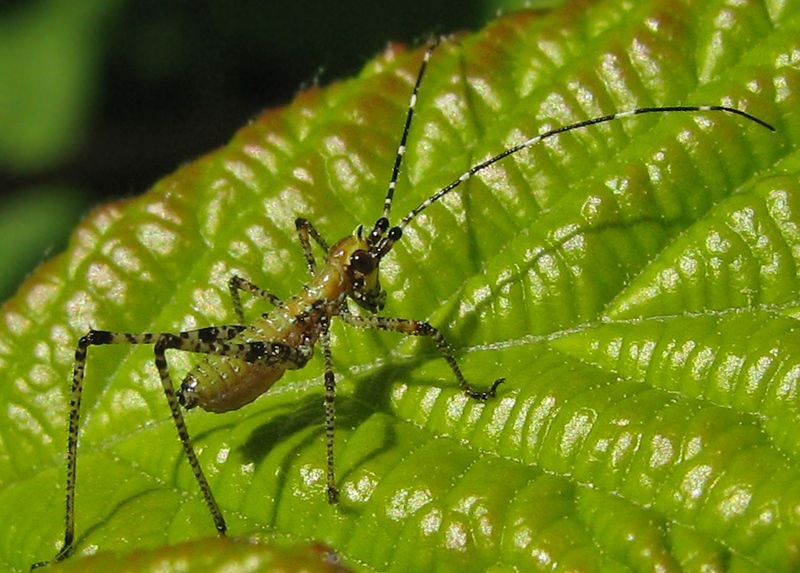
Possibly the first native katydid to be observed on Vashon-Maury Islands (Scudderia furcata). We are awaiting confirmation. photo by: Harsi Parker
This year Harsi was particularly excited about having found what she tentatively believes is the first native katydid she has seen on the islands–Fork-tailed Bush Katydid nymph (Scudderia furcata). We are awaiting confirmation. In addition, Harsi observed that the cross section of insects in these dry areas was somewhat different than the wetter Bioblitz locations we have surveyed in the past which brought in some new creatures for our island lists including possibly two new fly families (Bee Flies (Family Bombyliidae) and Thick-headed Flies (Family Conopidae)) and a few biological control agents (a Leaf Beetle (Family Chrysomelidae) often brought in to control St. John’s-wort and a Seed Weevil (Family Brentidae) that can control Scotch Broom.
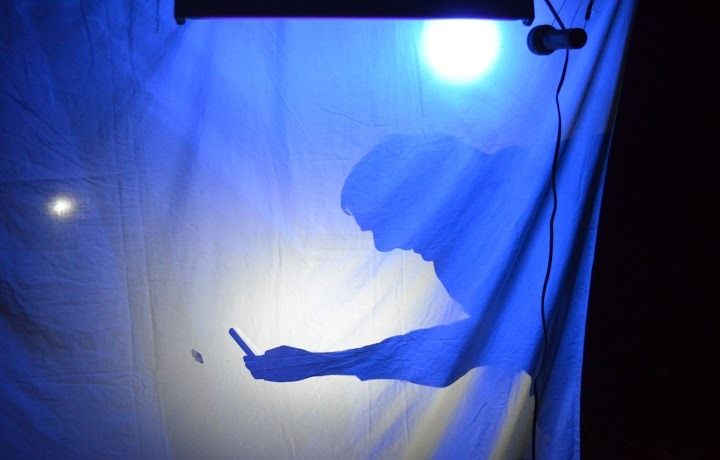
David Giuon photographs night insects at the Dockton Park black light. Together our two black light efforts brought in an estimated 40 unique night taxa. photo by: Kelly Keenan
Alan Warneke and Michelle Ramsden had good success with their black light trap at Maury Marine Park, pulling in about 30 night time taxa of moths, wasps, beetles, craneflies and others. Bianca Perla, Kelly Keenan, Natalya Bender, and Cazimir and Bohdin Mozeleski set up a black light at Dockton Park, which after some finagling to avoid parking lot lighting, pulled in upwards of 14 different taxa.
Shoreline
What a shoreline team we had this year, and we needed them!!! We covered 3 very different looking beaches over two low tide periods during the BioBlitz and the initial count estimate hovered around 100 different species!
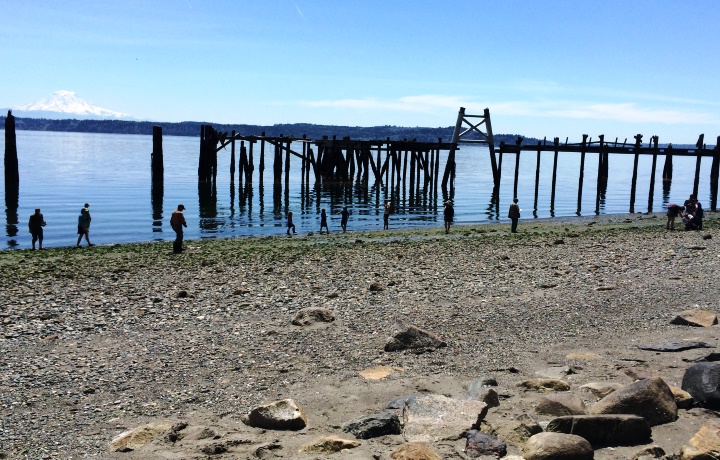
Beach naturalist teams survey Maury Natural Area beach, one of three beaches covered in Bioblitz 2015. photo by: Bianca Perla
Our shoreline teams were led by: Rayna Holtz (head team leader, Vashon Beach Naturalists), Shannon Hennessey and Jeff Adams (UW), Jamie Kilgore (Washington DNR), Gina Piazza and Doris Smalls (WDFW).
Chad Widmer from Pt. Defiance Zoo and Aquarium magically appeared Friday afternoon to give us a detailed species list of jelly fish. Maria Metler, Kelly Keenan, Amy Bogaard, Adria Magrath, and Leslie Enzian ran snorkel surveys for organisms at Dockton and manned our touch tank at base camp this year much to the delight of base camp visitors and staff alike.
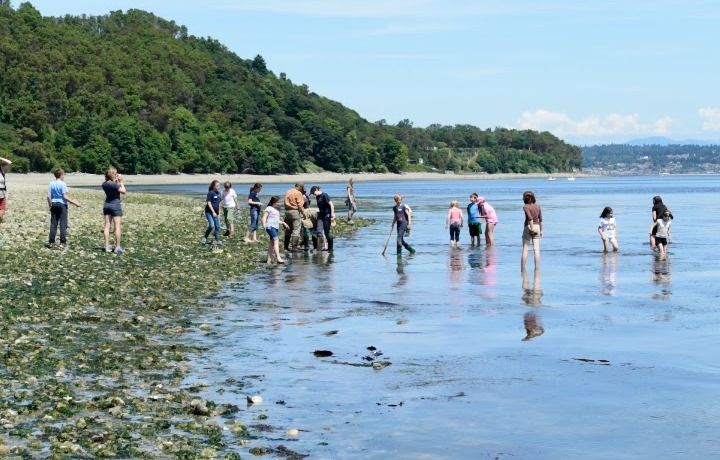
Harbor school 5th graders joined the Bioblitz count on Friday afternoon helping both beach naturalists and reptile teams gather data at Maury Marine Park. photo by: Kelly Keenan
Reptiles and amphibians
Harbor School 5th graders helped with both the shoreline survey at Maury Marine Park Friday afternoon and the reptile survey. Eager eyes and great exploratory instincts resulted in us finding western fence lizards within minutes of the start of the count. As mentioned in the plant section, the south facing, dry and exposed slopes of Maury Island create a unique habitat. Consequently, these areas are some of the only areas where certain reptiles, like western fence lizard and rubber boa, are found on the islands. We had the highest number of reptile species counted in a BioBlitz on Vashon so far which, incidentally, is only 3: Western Fence Lizard, Alligator lizard, and Northwestern garter snake.
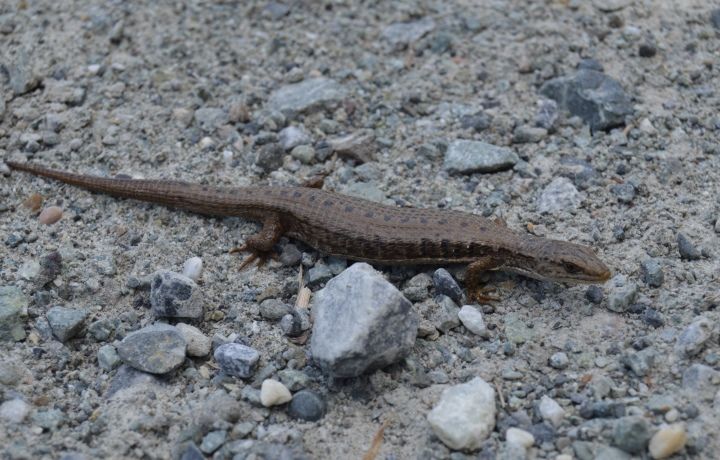
Northern alligator lizard (Elgaria coerulea). As most observations of this lizard over the weekend were fleeting this photo taken by Bella Ormseth was critical in confirming identification.
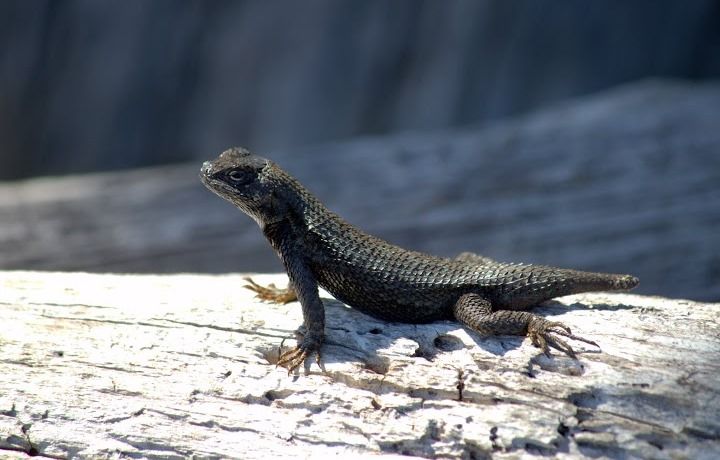
A western fence lizard (Sceloporus occidentalis) sunning at Maury Marine Park. Some sources say that these lizards can appear dark, almost black like this one, before they have warmed in the sun. Otherwise they are gray and tan in color with chevrons and stripe. The males have blue throat patches. photo by: Kelly Keenan
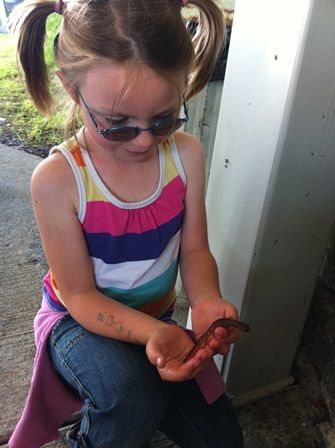
Zea Day Tharp holding her notable find, an ensatina and the only amphibian in the count this year, before returning it to its home. Ensatinas can be very site specific using the same location (under their favorite sword fern for example) for multiple years. photo by: Kathryn True
Try as we might the elusive rubber boa snakes never made an appearance, even with our pit trap efforts and night walks, but they have been seen in these seaside bluff habitats in the past and boy could we feel their presence in some of those suspicious looking holes we found.
Seven year old Zea Day Tharp made a pivotal discovery at base camp on Saturday morning. Her cries of, “Bianca, Bianca, Bianca!! …..I FOUND AN AMPHIBIAN!!!!” were music that is still echoing in my ears. Her discovery gave us the only amphibian of the count despite our dropboard lines and rotten log searches, way to go Zea! And thanks to the ensatina for showing up to be counted.
Birds
Ezra Parker, Kathryn True, Karen Fevold, Sue Trevathan, Steve Caldwell, and Sherry Lee Bottoms rounded out our bird team bringing in 60 different bird species. Steve took on the owling shift and was able to record a barred owl ironically only on his way to meet the survey team that night. Still it counts! Some other exciting finds include a barrow’s golden eye that was sticking around Dockton slightly late in the season, and drum roll please, 3 Marbled Murrelets foraging offshore at Maury Marine Park! This is nesting season for the federally threatened Marbled Murrelet and so this finding is a significant one. These birds need old growth trees (preferably 200 years old or more) for nesting and can forage far from their nesting sites (nests can be up to 15 miles inland from marine waters). Unless they have found some nice large trees on Vashon that we don’t know about, these Marbled Murrelets could be nesting somewhere in the old-growth forests of the Olympic Peninsula, and flying to our shores to forage on small fish and crustaceans. Just one more reason to keep our shorelines healthy, protected, and thriving for these hard working parents!
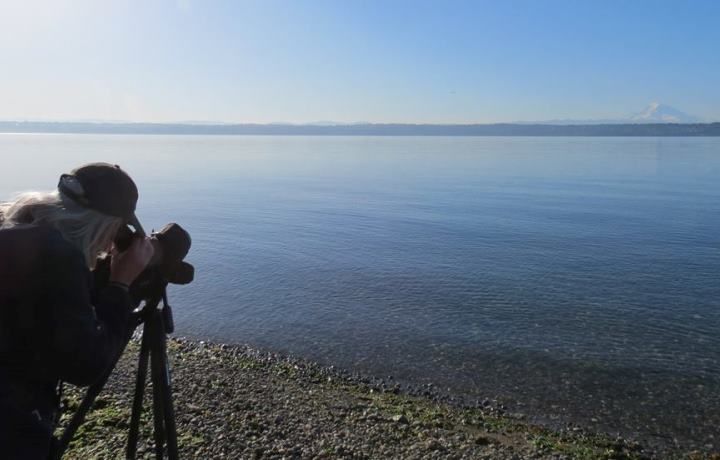
Sue Trevathan looking through her scope to find the surprise in the next photo! photo by: Sherry Lee Bottoms
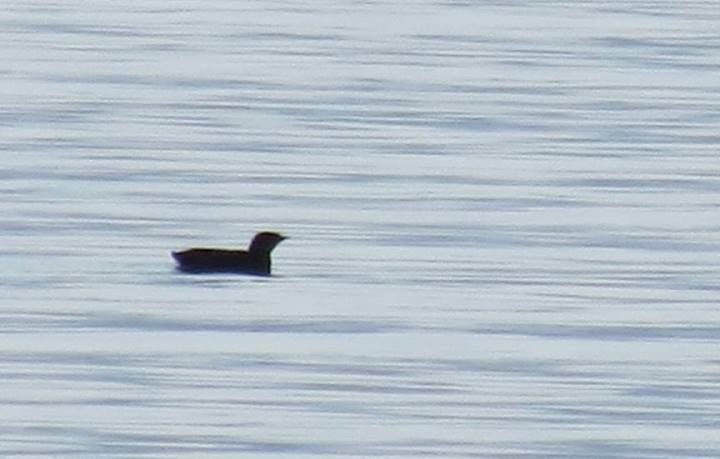
Federally threatened Marbled Murrelets were found by the birding team foraging off shore of Maury Island Marine Park. photo by: Sherry Lee Bottoms
Mammals
Thirty people turned out to help Ellen Kritzman and I set 50 live traps for voles and mice and 8 pit traps for reptiles and shrews in Maury Marine Park this year.
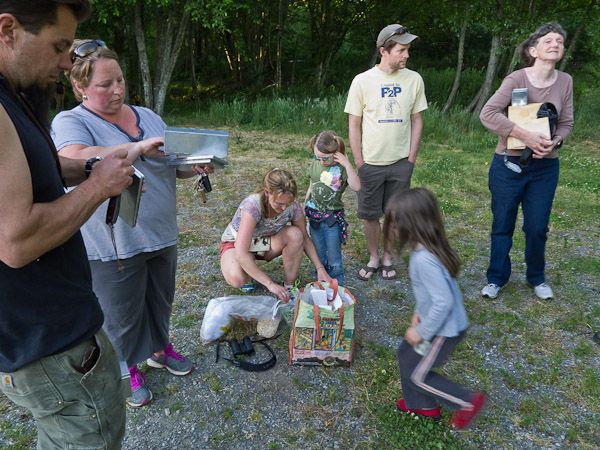
Participants help Bianca Perla unfold, load, and set live traps for small mammals to be checked early the next morning. We captured Townsend’s voles for the first time this year. photo by: Susie Fitzhugh
Participants helped us find signs of voles including tunnels, runways, and droppings. All this effort paid off because in addition to the ubiquitous deer mice, we got Townsends voles in our live traps for the first time.
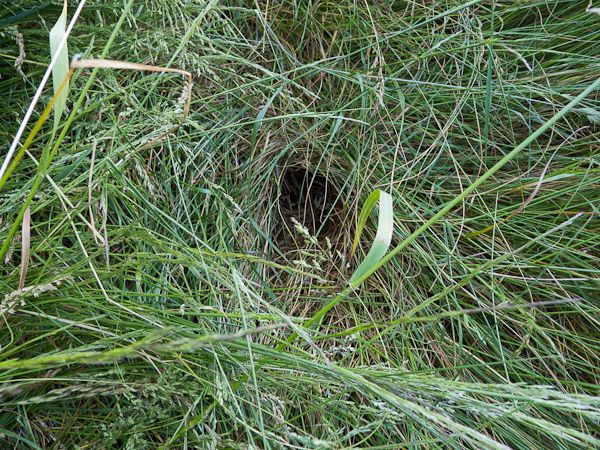
A vole tunnel, just one of many signs of small rodent activity that we look for when surveying for mammals. photo by: Susie Fitzhugh
We also measured the tail lengths of our deer mice. Deer mice that are more arboreal tend to have longer tails and hind feet to help them negotiate tree habitat. We found one candidate with a slightly longer tail than others (72 mm tail length) who coincidentally was trapped in the forest rather than the meadow. The tail length was on the high end but still falls within the described tail range for the species of 45-105mm.
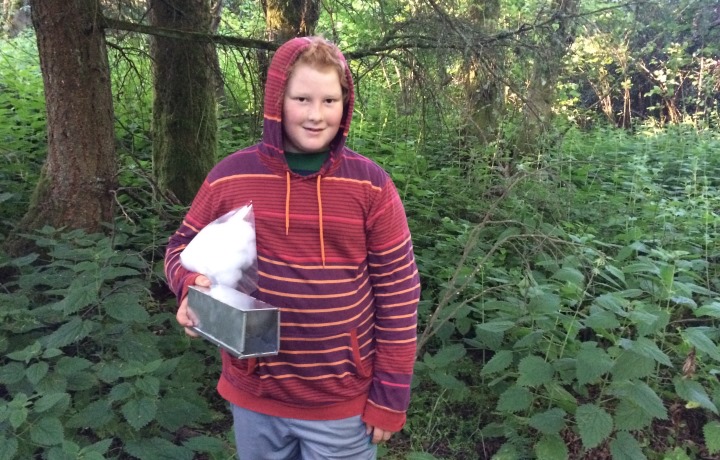
Quinn Williams, surprisingly chipper on 4 hours of sleep, helps mammal experts collect the mammal traps. photo by: Bianca Perla
Just as we were putting away the last live trap on the Maury Marine Park shoreline one of our mammal crew, Will Grace shouted, “Look!” We all turned towards the marine world and were treated to 5 Dall’s porpoises swimming by!
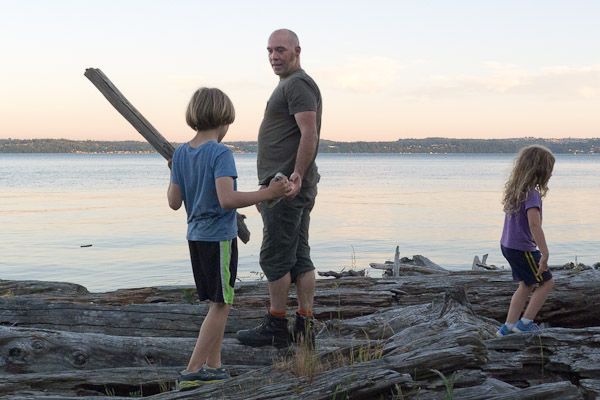
Part of the mammal team, Jason and River WIlliams and Isa Knowler, were drawn to the beach after Dall’s porpoises were seen. photo by: Susie Fitzhugh
Wilderness trackers Ted Packard and Annika Fae observed both a Townsend’s chipmunk and mink tracks (the actual mink was glimpsed by Orion and Isa Knowler and Quinn Williams who were not 100% sure of what they saw, so Ted and Annika’s track identification was crucial to the confirmation). Kathryn True found coyote scat and many beach goers reported harbor seal sightings. Our wildlife cameras brought in photos of raccoons, Canada geese, and black-tailed deer. A dead shrew found on the trail rounded out the count at 14 species.
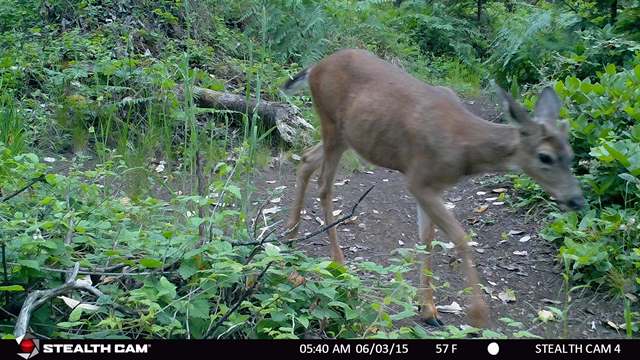
A young buck passes by wildlife camera 5 in the early morning. One of our wildlife cameras on the shoreline had 3000 photos on it. We got very excited until we realized it had been tripped with each wave! Cameras also captured raccoons, birds, dogs, and humans.
Base camp
What a base camp crew we had this year! One of our participants who had been to the first BioBlitz in 2012 and who had not been able to return until this year gave us some good perspective on how our efforts have grown. In 2012 Yvonne Kuperburg held down a base camp of 1 under a small canopy with a tiny card table and a cardboard sign. This year we had 16 base camp volunteers, including a stellar nightguard and set up take down crew (thanks to Cazimir and Bohdin Mozeleski and the Land Trust intern crew)!
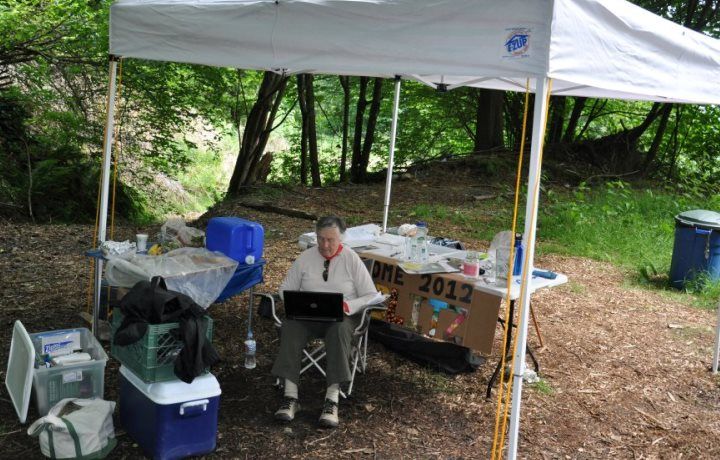
Yvonne Kuperburg holding down basecamp as the ONLY basecamp volunteer in our first BioBlitz. Yvonne, gets the BioBlitz best volunteer award as she has been at basecamp every single year since. Thank you Yvonne!! photo by: Bianca Perla

Finally we got Yvonne some help. Thank you basecamp crew 2015! Look how we’ve grown. photo by: Jane Neubauer
Besides signing everyone in, keeping a base camp species list, and keeping all efforts organized and coordinated our base camp crew got to oversee interpretive booths from the Vashon Beach Naturalists, Washington Department of Natural Resources and others.
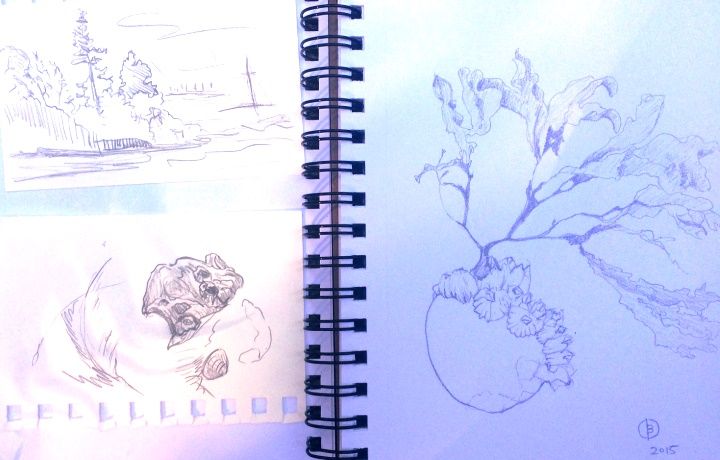
A biological illustration table at basecamp generated beautiful sketches of some of the scenes from the weekend. Thank you to our artists, biological illustrators and members of the general public who tried their hands at this table!
We also had a drawing table where anyone could try their hands at biological illustration under the guidance of professional illustrators and artists: Gay Roselle, Bella Ormseth, and Sandra Noel. Susie Fitzhugh and Alex Koriath created some lovely and engaging activities for a junior ranger program and the Audubon button making machine was put to good use making buttons for many new junior naturalists.
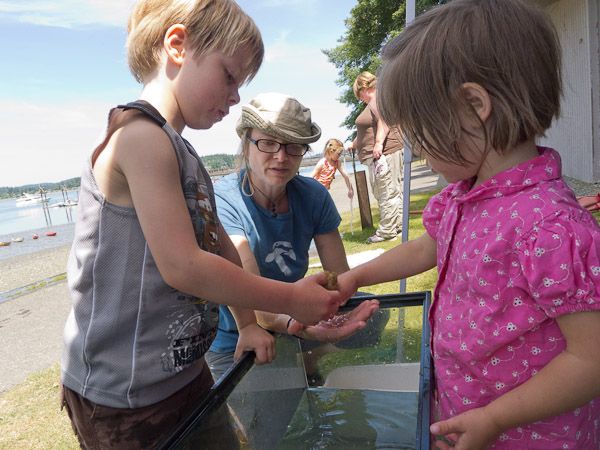
Adria Magrath teaches new BioBlitzers the ropes at the base camp touch tank. photo by: Susie Fitzhugh
Karlista Rickerson, Adria Magrath, and Hazel Wilding manned our microscope tables throughout the event along with scientists from the field who used these scopes to help them identify marine, insect, and fungi species.
Our sponsors
The Mountaineers Foundation, Vashon Maury Island Land Trust, Washington Department of Natural Resources, King County, and Vashon Watersports have been instrumental in our ability to improve this event and provide more depth, capacity, and fun for everyone involved. Thank you!!!!
Thanks to all
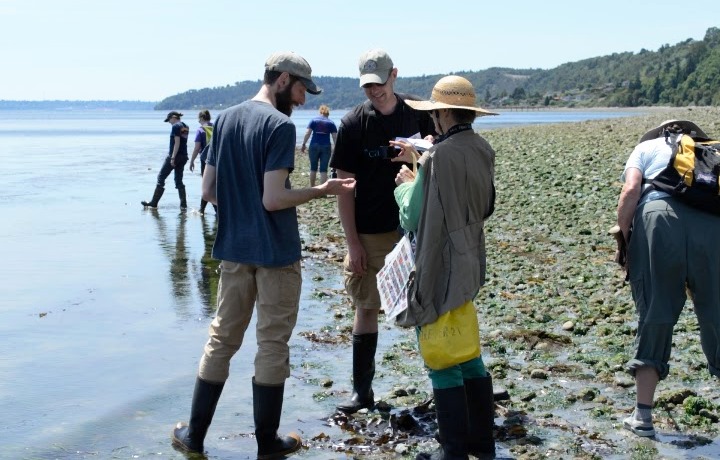
Building community. Each year BioBlitz events bring together more naturalists of all experience levels to learn from each other and enjoy exploring nature together. All of these folks are walking treasures. photo by: Susie Fitzhugh
We had over 175 people participate in the BioBlitz event this year. THANK YOU everyone!!! This work that we do together is not only fun, it is important. The natural history information that we generate and the growing and deepening naturalist community are rich community assets.
Today, in all aspects of society, from research and education to politics and popular culture, focused attention on the natural world is slim. Yet the fundamental knowledge generated by careful observation (where species live, what other species they are associated with, what their needs and habits are, how they are changing through time) is critical to many important decisions we make concerning the function of natural systems—the same systems that support our own species physically and spiritually. All of you who have participated in the BioBlitz events help to turn the tide just by using your senses to observe the reality of the larger world around you.
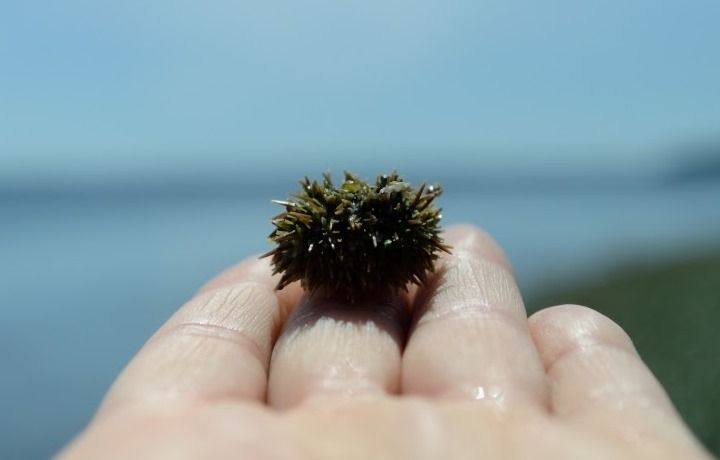
Through the eyes of a naturalist even the small things in nature can take your breath away. Sea urchin photo by: Kelly Keenan
When participating in careful observation of nature alongside others for a full 24 hours, I cannot help but increase my sense of respect and gratitude for the earth in which I live. Each time I participate I become more rooted in the reasons I do this work: I love the wilds of these islands strongly; I love the authentic, humble, and joyful curiosity that emanates from our local community of naturalists and from the new people drawn to this event each year; and I love the renewed perspective I get from seeing such detail in life and from witnessing how beautifully people of all ages can connect with the non-human elements of our world and with each other.
Renowned naturalist and educator Thomas Fleischner speaks of what happens inside us when we focus our attention on the natural world: “It prods us out of our own melodramas, connects us with larger forces and mysteries, and maybe even offers ideas for new human habits. The Earth doesn’t so much ask as invite us—to live fully awake and alert to each new moment. Seeing what is really there, imagining what lies beyond our sight.”—from Fleischner’s essay, What does Earth ask of us?
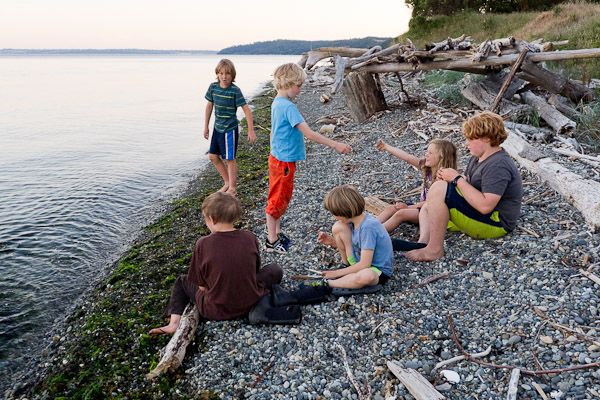
Part of the new generation of naturalists building their connection with nature and with each other. photo by: Susie Fitzhugh
Although this year’s BioBlitz has ended, let’s all make a commitment to keep growing our healthy sense of curiosity. This curiosity invites us to notice, imagine, and connect so that our relationship with nature and with each other continues to deepen. It’s good for us and for the planet. See you at BioBlitz 2016!!!
Featured photo–Mt.Rainier from Maury Natural Area by: Kathy Bosler
Further reading/listening
More photos of the blitz
Naturalist JOSH TEWKSBURY on why this is the best time to be a naturalist and why you don’t need a PhD for it.
Thomas Fleischner’s Natural History and the Spiral of Offering essay

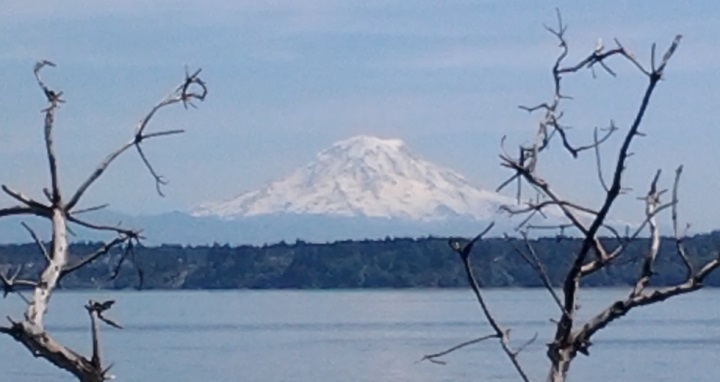
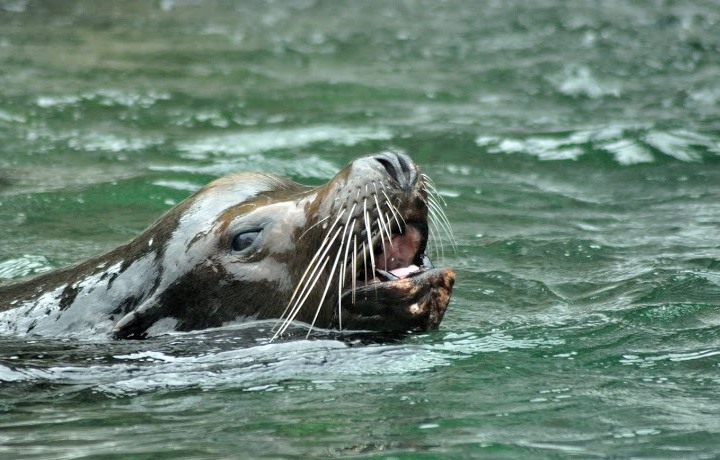
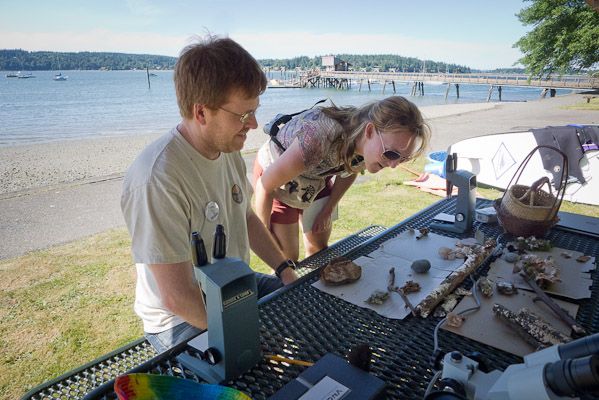
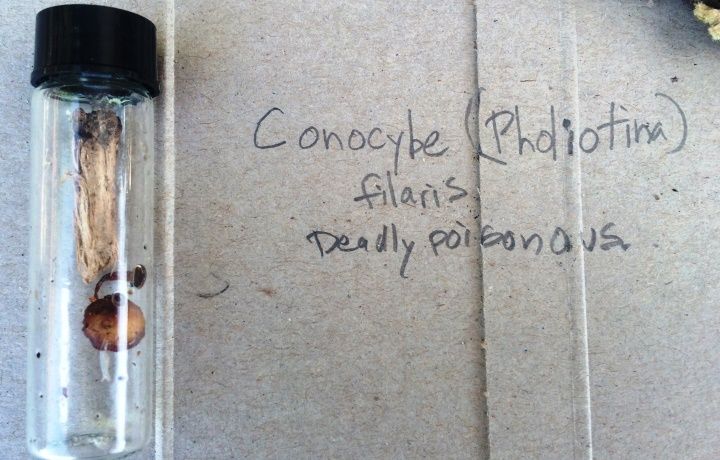

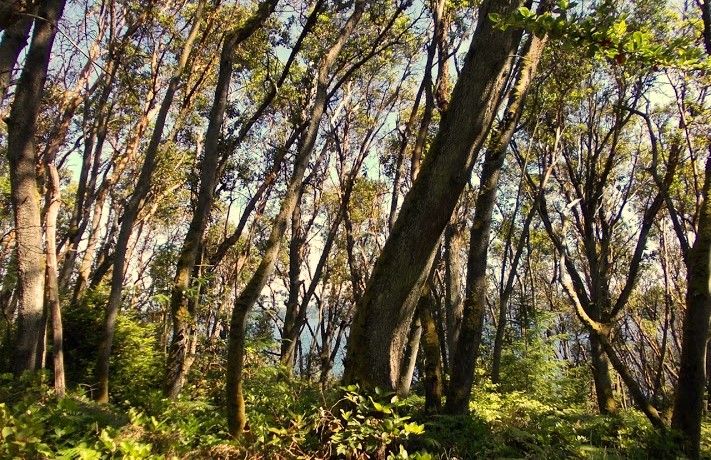
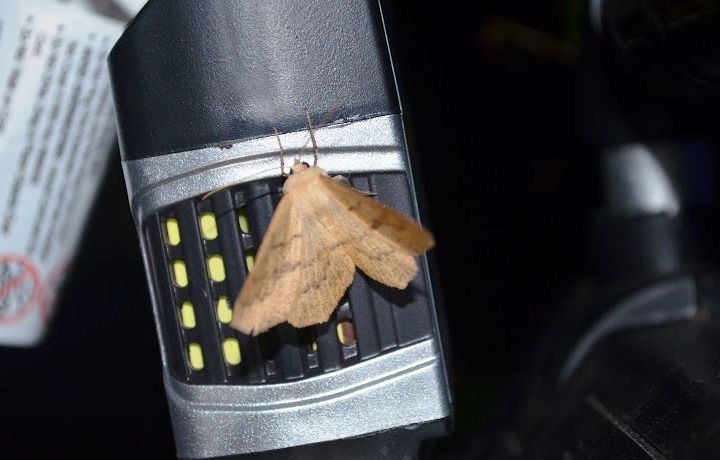
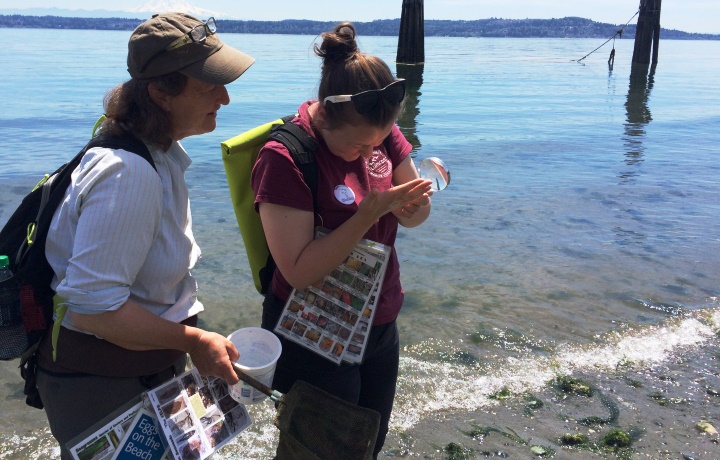
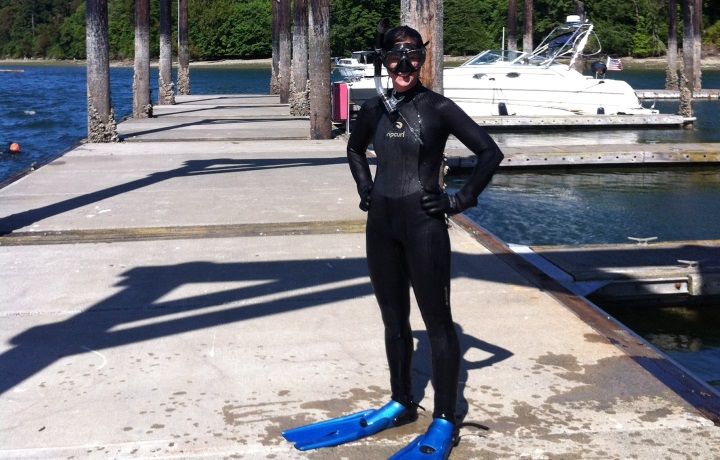
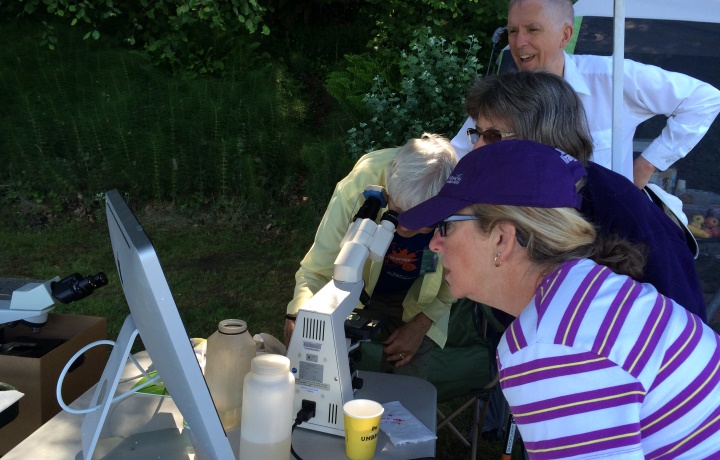
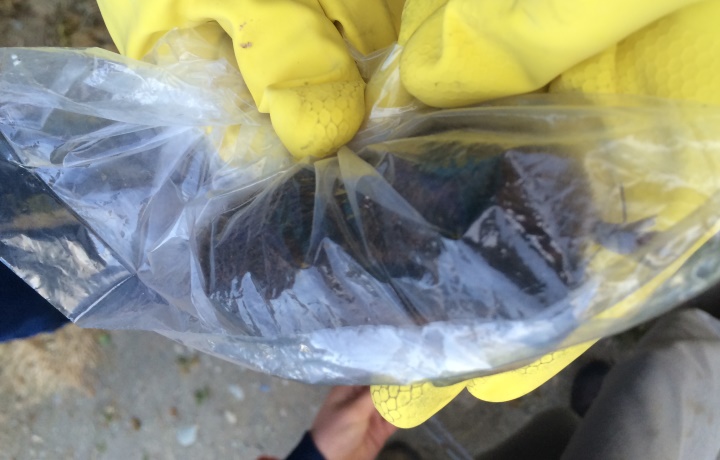
Thank you for such an inspiring report. I will be there next year for sure!
Hi Bianca,
So sorry I wasn’t able to participate this year. The weather was great and you saw so much! (I have seen the rubber boa there a couple of times in the past.) Congratulations on an exciting Bioblitz. Loved your narrative. Also terrific how many children are involved.
Please note my email for gmail rather than earthlink for future communications.
Thank you!
Laura
Great report!!!!! Great event!!!!! Keep ” seeing” …and thanks to rayna for helping me understand the mystery of how clam shells grow..!!!!! G
Beautifully written, Bianca! I wish I’d been able to join in but you give me an exciting glimpse of what it was like. Hopefully next year ….!
This was my first Bioblitz, and I enjoyed it immensely. Having Jim Evans leading the plant team enabled us to identify far more plants – because of his incredibly deep knowledge of the Latin names of all the plants. I look forward to participating again next year. Diane
This is my third Bioblitz at basecamp. So fun to support everyone and see what gets brought in. Amazing write up Bianca!
Thanks to everyone for making this happen.